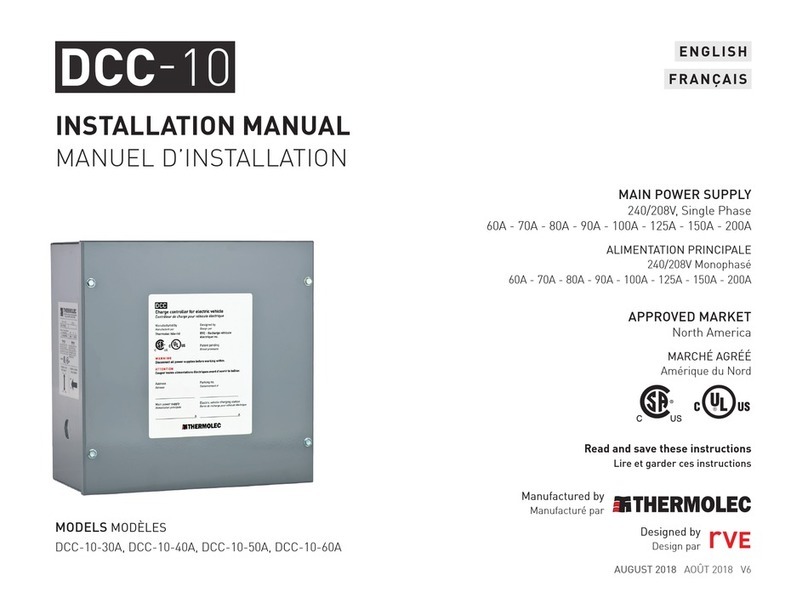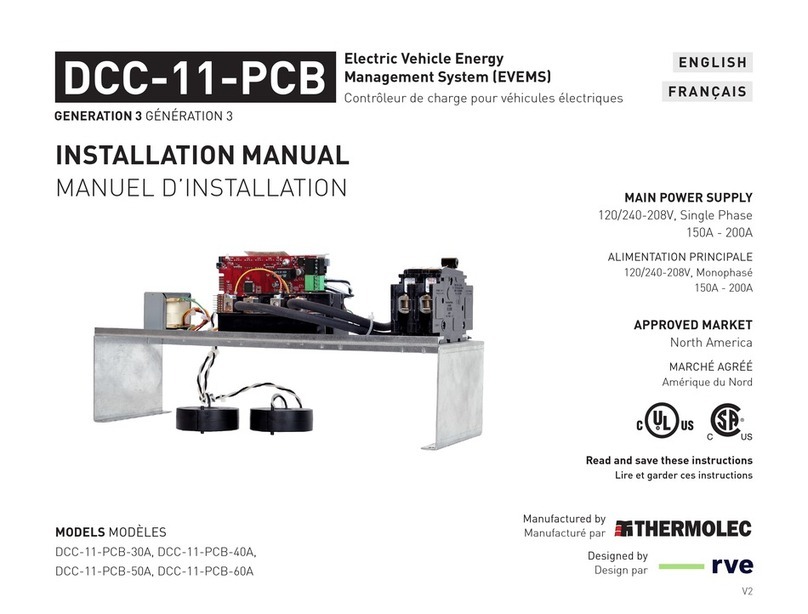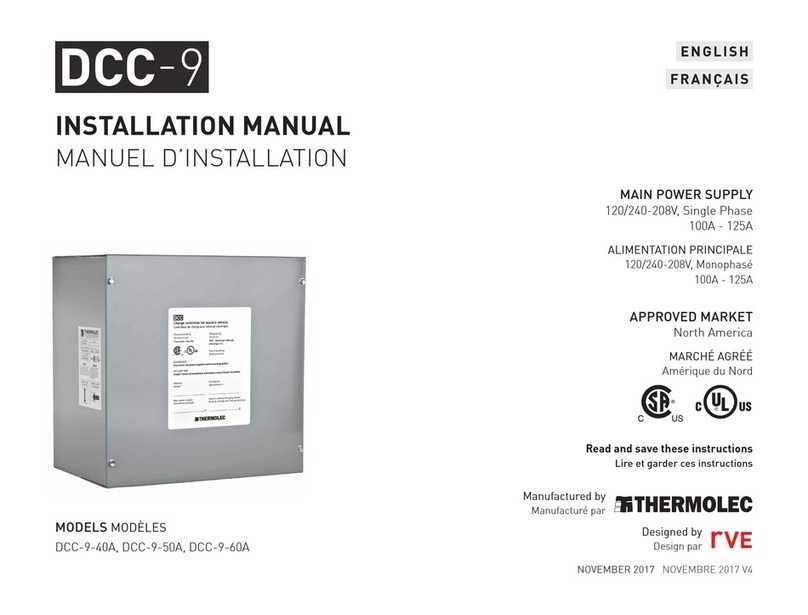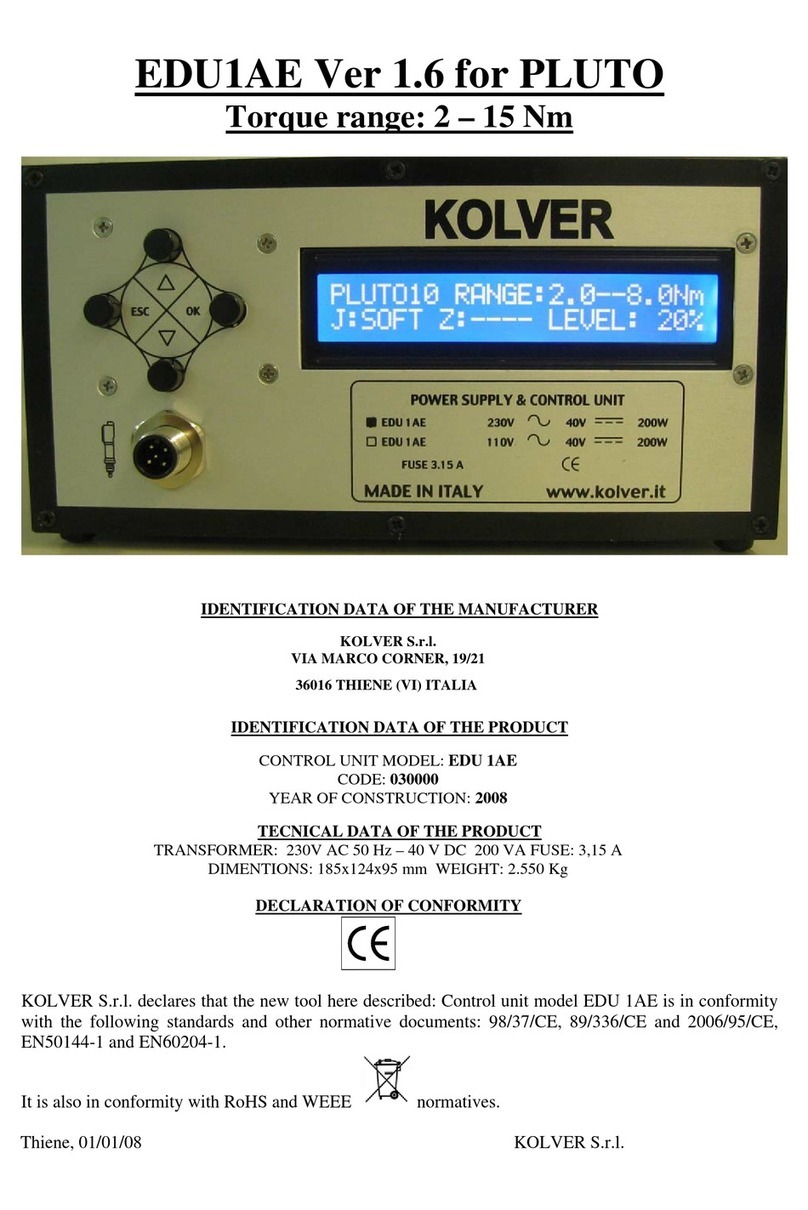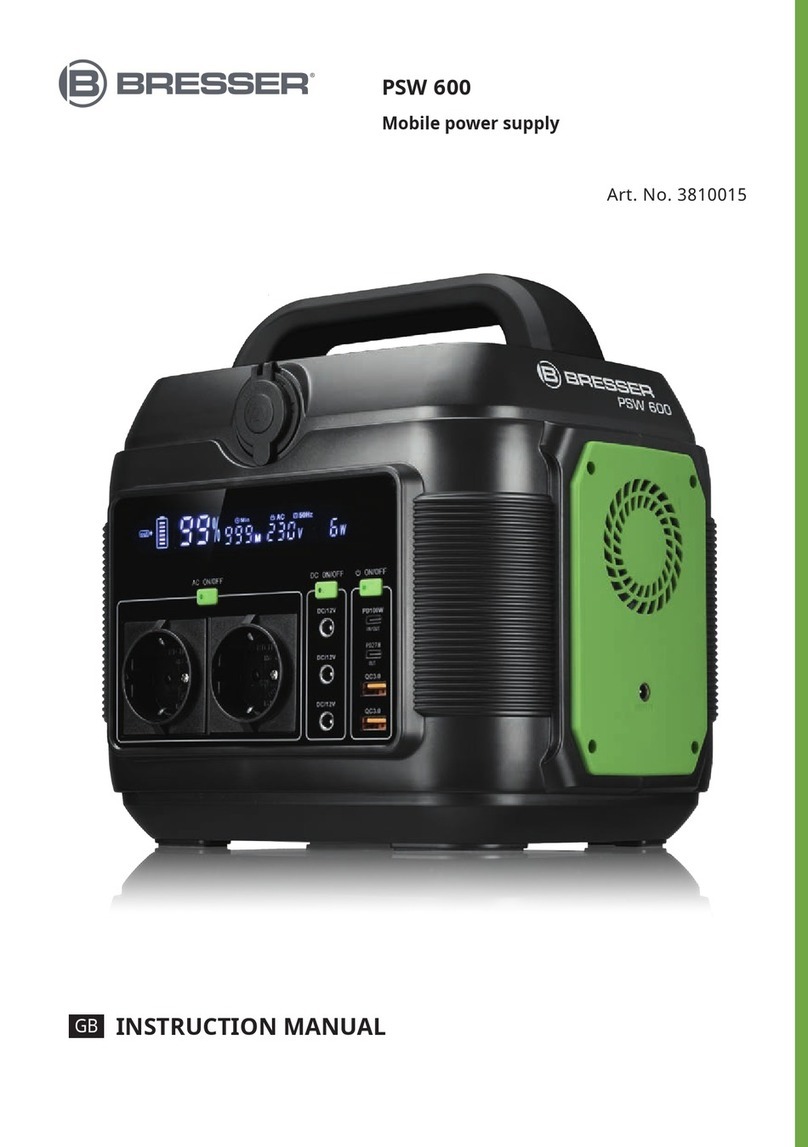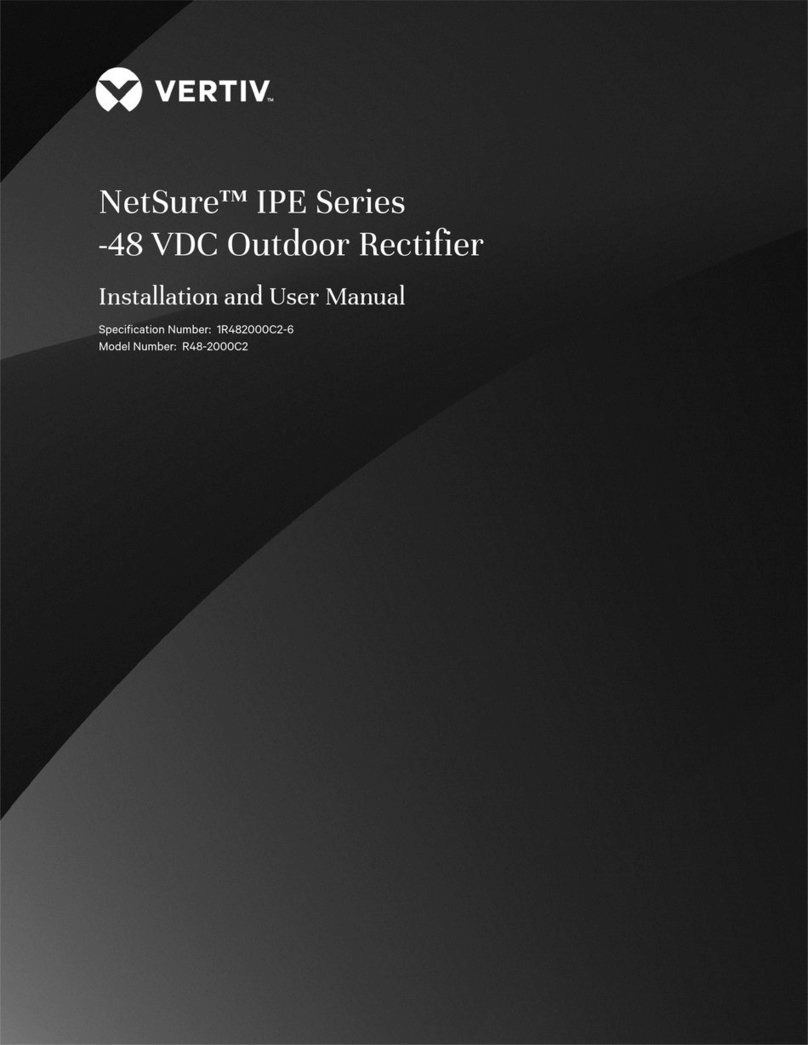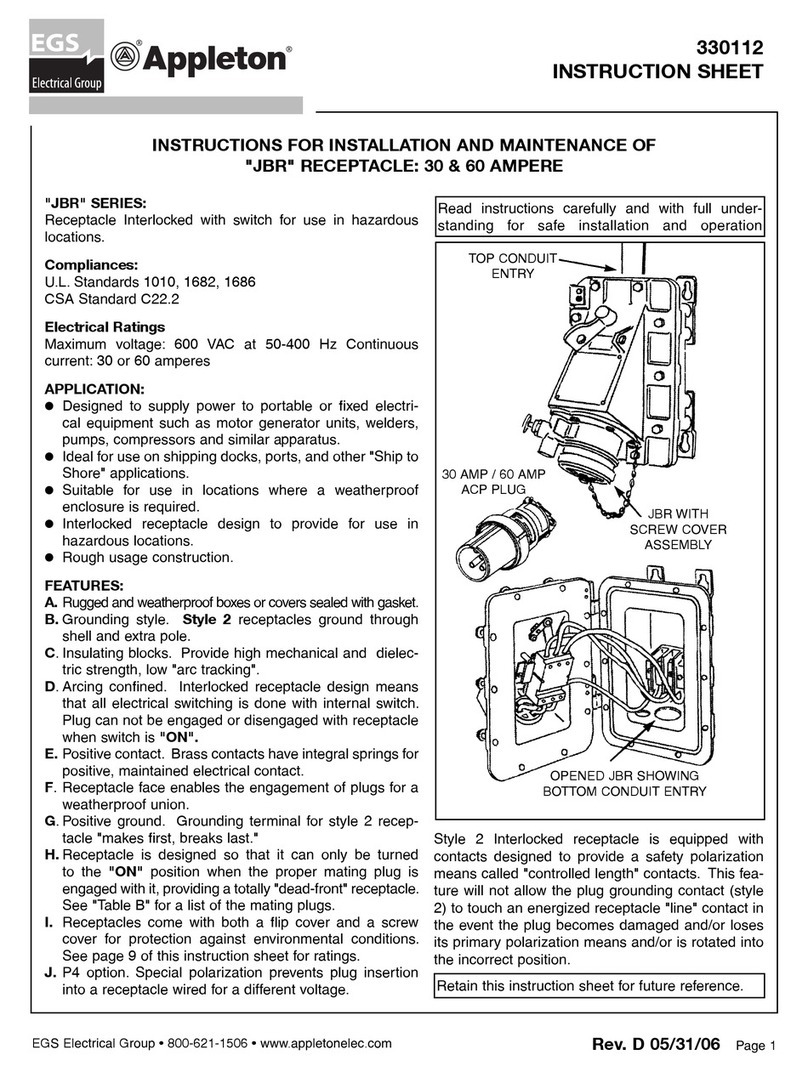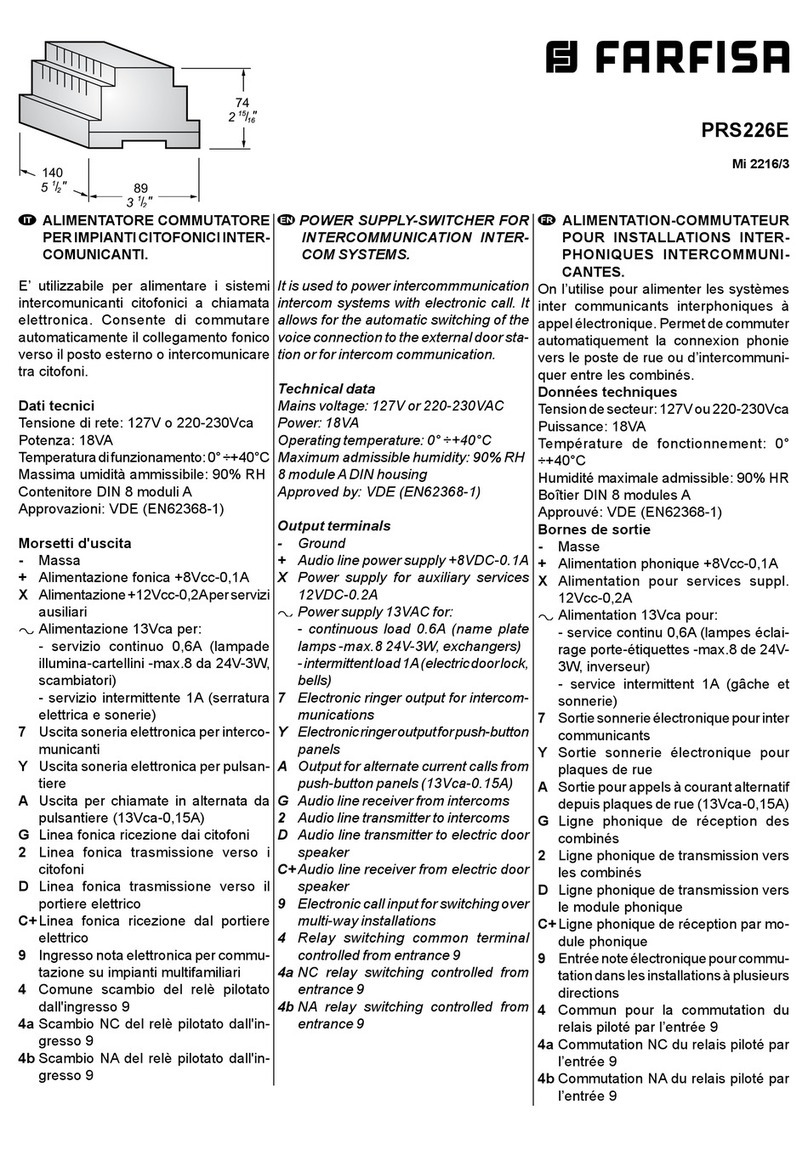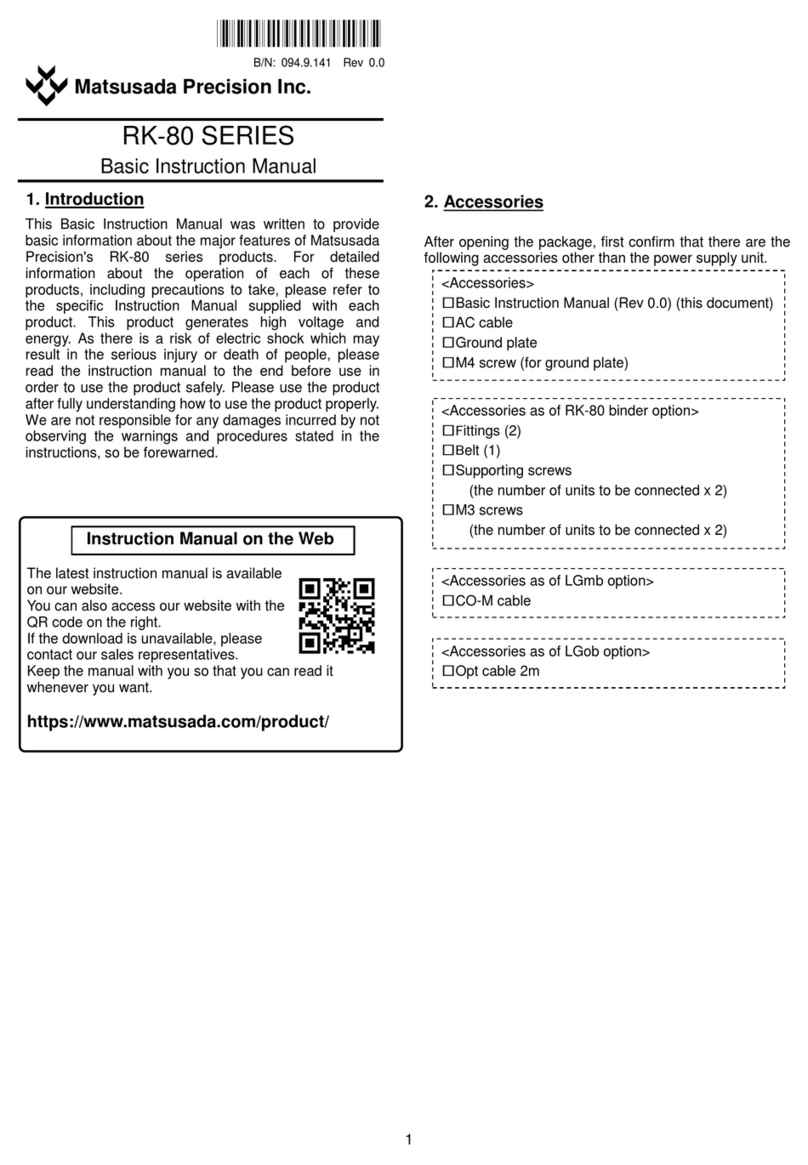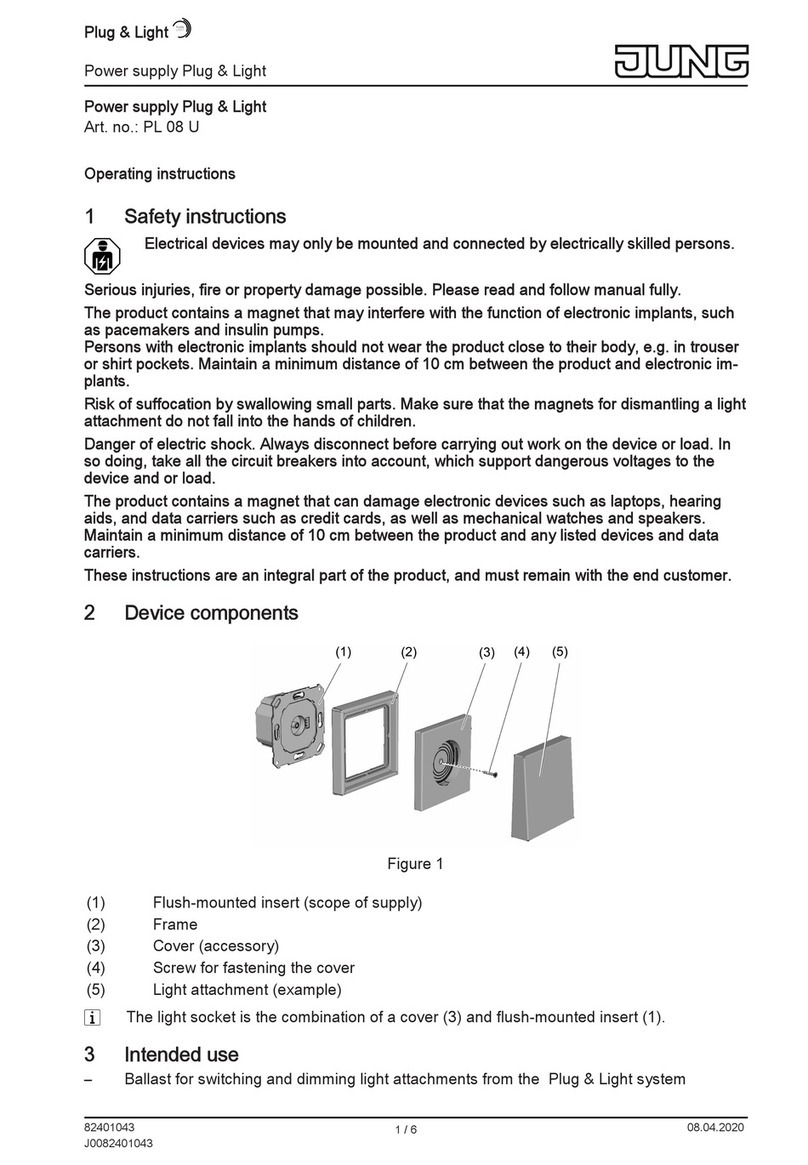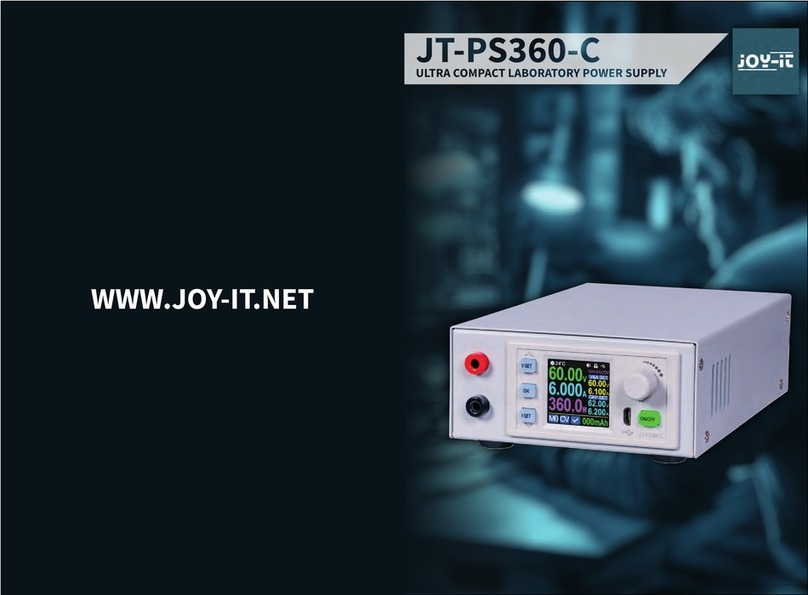Thermolec rve DCC-12 User manual

1
INSTALLATION MANUAL
MANUEL D’INSTALLATION
Electric Vehicle Energy
Management System (EVEMS)
Contrôleur de charge pour véhicules électriques
MAIN POWER SUPP LY
240-208V, Single Phase
60A - 70A - 80A - 90A
100A - 125A - 150A - 200A
ALIMENTATION PRINCIPALE
240-208V, Monophasé
60A - 70A - 80A - 90A
100A - 125A - 150A - 200A
APPROVED MARKET
North America
MARCHÉ AGRÉÉ
Amérique du Nord
MODELS MODÈLES
DCC-12
V8
Read and save these instructions
Lire et garder ces instructions
IFRANÇAISI
IENGLISHI
GENERATION 3 GÉNÉRATION 3
Manufactured by
Manufacturé par
Designed by
Design par
DCC-12
Nema 3R Enclosure
Boitier Nema 3R

2

3
ABOUT THIS MANUAL
ERRORS AND INACURACIES
For any inaccuracy or omission, or to forward any general comments or
suggestions concerning the quality of this manual, please send an email
to suppor[email protected].
COPYRIGHTS AND TRADE NAMES
All information’s in this manual are subject to copyright protection and
other intellectual property protection of THERMOLEC LTÉE. / RECHARGE
VÉHICULE ÉLECTRIQUE and its licensors.This installation manual cannot
be modied, reproduced or copied without a prior written authorisation
from THERMOLEC LTÉE. / RECHARGE VÉHICULE ÉLECTRIQUE and
its licensors. Additional information’s are available on request. The
following logos are trade names or trademarks of THERMOLEC LTÉE. /
RECHARGE VÉHICULE ÉLECTRIQUE in the United States and in Canada.
DCC – EVEMS
All other trade names mentioned in this document are the property of
their respective owners and their uses in this manual does not means
a sponsorship or approval of the product. The use of any trade name
shown in this document is strictly forbidden.
In this document, the terms DCC – EVEMS and DCC are equivalent.
TABLE OF CONTENTS
About This Manual 3
Safety Information 4
Specications 5
Characteristics 5
Typical installation 6
DCC Installation 7
Application 11
Maintenance 11
Lights Code 11
IENGLISHI

4
SAFETY INFORMATION
This document describes important safety instructions which must be
followed during installation, maintenance and application of the DCC –
Electric Vehicle Energy Management System (EVEMS).
Warning
Read all instructions prior using this
product.
Always disconnect the DCC – EVEMS
power supply before any works.
Use only the DCC – EVEMS by following
the technical specications indicated in
this installation manual.
Do not install the DCC – EVEMS nearby
inflammable materials, explosives or
fuels, chemical products and vapors.
Never spray the DCC – EVEMS with
water or any other liquids.
Stop using the DCC – EVEMS
immediately if defective, cracked, broken
or damaged.
Never try to modify, repair or dismantle
the DCC – EVEMS. Please contact the
manufacturer for any malfunction.
Never insert a sharp object inside the
DCC – EVEMS at the risk of causing
damages to the components.
Any improper use of the DCC – EVEMS
could result in serious injuries which
may cause death.
For a vertical installation on a wall, refer
to the information’s on the enclosure for
the choice of mounting position.
Precautions
Any improper use of the DCC – EVEMS
can cause damages and premature
wear of the components, which voids
the warranty.
Operating temperature:-22 °F to 113 °F
( -30 °C to 45 °C )
Storage temperature:-4 °F to 158 °F
( -20 °C to 70 °C ).
The installation of the DCC – EVEMS
must be done in accordance with the
latest local electrical code requirements.
Notes
It is recommended to schedule the
charging of the vehicle during hours of
low electrical consumption to minimize
interruptions to the electric charging
station.
Always check that the DCC – EVEMS is
adequately xed to the wall or ceiling or
in a location to avoid any damages.
Not limited to compatibility with electric
vehicle charging stations, this product
can be installed with resistive loads
of up to 60A and inductive loads of up
to 40A.
It is the installer’s responsibility to
make sure that the electric power
source is adequate for the use of the
DCC – EVEMS.
Do not use any cleaning solvents to
clean the DCC – EVEMS.
Limited warranty
1RECHARGE VÉHICILE ÉLECTRIQUE
warrants the integrated controls
against any defects for a period of
one year from the shipping date. The
warranty is limited to the equipment
and components supplier by
RECHARGE VÉHICULE ÉLECTRIQUE
2In case of incorrect installation,
inappropriate use or repairs done by
unauthorized personnel by RECHARGE
VÉHICULE ÉLECTRIQUE, the warranty
will be automatically void.
3 RECHARGE VÉHICULE ÉLECTRIQUE
undertakes to repair or replace, at
site or at the manufacturing location,
at his option, the defective material
only after an evaluation made by its
representative.
4 RECHARGE VÉHICULE ÉLECTRIQUE
will not be held liable for damages or
delays and will not be required to pay
transport cost of the EVEMS said to
be defective.
5RECHARGE VÉHICULE ÉLECTRIQUE.
shall not be liable for any indirect
damages or delays caused by faulty
workmanship or materials.
No indemnity will be paid for repairs,
replacements or modications without
a prior written consent supplied by
RECHARGE VÉHICULE ÉLECTRIQUE
6Any control device or accessory
supplied with the DCC – EVEMS to be
installed or connected remotely from
the EVEMS will be guaranteed by the
manufacturer only under the special
conditions mentioned in paragraph 5.
7The components supplied for repairs
are guaranteed for the remaining of
the warranty on the original product
or 90 days. The longest period will
prevail.
8All repairs made at the RECHARGE
VÉHICULE ÉLECTRIQUE plant are
guaranteed for 30 days from the date
of repairs.

5
CHARACTERISTICS
CONDITIONS FOR APPLICATION : The DCC-12 is an Energy Management
System specially designed to allow the connection of an EV Charger, in a house or
dwelling, to an electrical panel that is at full capacity and would otherwise need to
have an expensive service upgrade.
OUTDOOR INSTALLATION : The DCC-12 has a NEMA 3R enclosure approved
for indoor and outdoor installations.
The following options are offered depending on EV charger breaker:
BREAKER MAIN POWER SUPPLY
EV charger 60A 70A 80A 90A 100A 125A 150A 200A
30A
40A
50A
60A
Voltage and wiring 240/208V AC single phase:
L1, L2, Neutral, Ground.
Frequency 50 à 60 Hz
Operation temperature -22°F à 113°F (-30°C à 45°C)
Rated NEMA 3R
Wire Gauge Size up to 250 kcmil (MCM) (CU/AL)**
Max torque Relay terminals: 40 in-lbf
Dimensions*(H" x W" x D") 11" x 8" x 5"
Total weight*8 lb (3,63 kg)
*Approximative and can change without notice.
** See Connecting aluminum conductors section in the installation manual V4
MAIN POWER SUPPLY (CB) : The DCC – Electric Vehicle Energy Management
System can be powered by a 240/208V AC single phase source.
SECONDARY LOAD SUPPLY (EVC)
The DCC – EVEMS will provide power to a charging station through a 30A, 40A, 50A or 60A
240/208V AC circuit breaker, L1, L2 and ground. The DCC-12 is NOTequipped with an internal
breaker. The breaker to protect the branch circuit needs to be provided by the installer.
TRIP PERCENTAGE (TP)
The DCC - EVEMS is factory set to turn off the charging station if the total consumption
of a service exceeds 80%. For other congurations, please contact the factory.
POWER OUTAGE
In the event of a power outage, the DCC – EVEMS automatically restore the power supply
to the vehicle charging station when power returns.
RECOVERY TIME (RT)
Following a power cut to the electric vehicle supply equipment (EVSE), a 15 minutes
delay is initiated to monitor the total consumption of the electrical power system. Power
to the vehicle will then be restored if the total load consumption is lower than 80% of
the main circuit breaker rating during a period exceeding the 15 minutes’ recovery time
CONNECTING ALUMINUM CONDUCTORS
RVE relays are suitable for the connection of aluminum conductors in accordance
with the documentation of the respective product and the following procedure.
When an aluminum conductor is stripped from its insulator, a thin non-conductive
oxide lm forms on the bare metal. This must be broken in order to create a conduc-
tive and gas-free connection. For this reason, it is necessary to perform the following
measures in order to guarantee a safe contact :
-Using a blade, the stripped end of the aluminum conductor must be freed from its oxide
lm and immediately dipped in non-acid and nonalkali connection paste.
-The installation site must be kept as free from humidity or aggressive atmospheres
as possible.
-When using an aluminum conductor, the lug screw must be tightened with the maximum
permissible torque.
-The pretreatment must be repeated when connecting the conductors anew.
SPECIFICATIONS
The DCC – Electric Vehicle Energy Management System (EVEMS) is a safety device with
programmable controller that can protect an electrical distribution circuit in relation with
its main breaker. It will prevent overloading the electrical distribution circuit by turning
off momentarily the power to the charging station when the demand exceeds 80% of the
main breaker rating.
BREAKER MAIN POWER SUPPLY
EV charger 60A 70A 80A 90A 100A 125A 150A 200A
30A
40A
50A
60A
Voltage and wiring 240/208V AC single phase:
L1, L2, Neutral, Ground.
Frequency 50 à 60 Hz
Operation temperature -22°F à 113°F (-30°C à 45°C)
Rated NEMA 3R
Wire Gauge Size up to 250 kcmil (MCM) (CU/AL)**
Max torque Relay terminals: 40 in-lbf
Dimensions*(H" x W" x D") 11" x 8" x 5"
Total weight*8 lb (3,63 kg)
*Approximative and can change without notice.
** See Connecting aluminum conductors section in the installation manual V4
*

6
CONTROL BY A THIRD PARTY SYSTEM (EMS)
The DCC control board has a dry contact type input
(black terminal) to be connected to a building energy
management system.
When the contact is:
- Open, the DCC cuts the power to the charging station.
- Closed, the DCC supplies power to the charging station, provided that
the main power supply of the DCC is under the only congured current.
The dry contact type output, which reproduces the state of the dry contact
input, allows several DCCs to be cascaded on a single control signal
TYPICAL INSTALLATION
DCC-12 with
MAIN PANEL
by
ELECTRICAL INFRASTRUCTURES
Current transformers
DCC-12 with
MAIN PANEL
Electrical
Meter
Main Panel
CHARGING
INFRASTRUCTURES
EV Charger
DCC-12
FOR HOMES
by
DCC-12 with
METER BOX PANEL
ELECTRICAL INFRASTRUCTURES
Electrical
Meter Main Panel
Current
transformers
EV Charger
CHARGING
INFRASTRUCTURES
DCC-12
by
Current transformers
Sub Panel
DCC-12 with
SUB PANEL
ELECTRICAL INFRASTRUCTURES
EV Charger
CHARGING
INFRASTRUCTURES
Electrical
Meter Main Panel
DCC-12
DCC-12 with
METER BOX PANEL
DCC-12 with
SUB PANEL

7
DCC INSTALLATION
STEP 1: CHECK THE PACKAGE CONTENTS
1 x DCC-12 2 x Current
transformer (CT)
(with 20 feet of wire)
1 x Screwdriver
STEP 2: PREPARATIONS FOR INSTALLATION
1. Disconnect the main power
2. Select the DCC intended location.
Select an intended location preferably less than 25 feet away from
the electric panel (power source). The current transformers supplied
have a wiring of 20 feet in length, but can be extended (see the section
Step 4: Conductor connexions for the extension details).
The DCC can be mounted:
- on a ceiling
- on a wall
NOTE: The DCC controller must be mounted so that the nameplate
remains visible at all times.
INSTALLATION VIDEO
To access our installation video,
visit our website www.rve-usa.com/products/dcc-12/
Do not install the DCC:
- In a location with high level of risk.
- Nearby inflammable materials, explosives or fuels, chemical
products and vapors.
3. Before installation, check the DCC mounting position.
Refer to the information on the enclosure to insure proper installation.
WARNING
Warranty automatically void if the DCC is installed incorrectly.
STEP 3: INSTALLATION
Wall installation
1. Remove the 4 cover screws.
2. Position the DCC at the intended location.
3. Ensure that the mounting is according with the information’s
on the enclosure.
4. Fix the DCC with the anchors provided for the type of surface.
5. Check that the DCC is adequately xed to the wall or ceiling.
STEP 4: CONDUCTOR CONNEXIONS
Consult the diagram on page 10 for all details on the
cable connections conguration. This diagram is
also found under the DCC cover.
Current transformers (CT) installation and connections
1. Open the CT.
2. Install the CT around the main power cable of the panel.
3. Check the correct polarity on the CTs.
4. Connect the CT cables provided for this purpose to the terminal
blocks (green terminal) on the DCC-12 control board.
5. Connect both shields to the ground lug of the DCC

8
EXTENSION OF CURRENT TRANSFORMERS’S WIRE
The DCC comes with 20 feet of wire. It is possible to extend the wiring
supplied with the current transformers. Additional wire must be 300V
rated, minimum 18 AWG (1mm²), 4 conductors (2 pairs) shielded &
twisted (ex: FT4 SHIELD. 2Pairs FAS #18 or equivalent).
STEP 5-A:
DIP SWITCH PROGRAMMING FOR MAIN POWER SUPPLY
1. Identify the set-up section on the DCC.
2. Set up the section as per the layout corresponding to the main
power supply :
Main Circuit Breaker (Amps)
Main power supply
60A 70A 80A 90A 100A 125A 150A 200A
EV Charger
(Breaker)
30A
40A
50A
60A
* Note: DCCs do not support congurations in which the charger circuit
(EVC value) is greater than half the capacity of the electrical input (CB
value). This is why, for example, the combination CB=100A, EVC=60A
prevents the DCC from being switched on (ashing red light).
However, it is possible to safely operate the DCC for a 60A charging
circuit on a 100A main electrical input using the following congura-
tion that provides a 60% load shedding threshold of 125A, i.e. 75A:
STEP 5-B:
DIP SWITCH PROGRAMMING FOR EV CHARGER (EVC)
EV Charger (Breaker)
30A 50A
40A 60A
STEP 6 (OPTIONAL): CONNECTION TO A THIRD PARTY
ENERGY MANAGEMENT SYSTEM
If a third-party system is to control the DCC, see step 6 at the end of
this manual.
If the DCC is not used with a third party system, do not
remove the jumper connecting the two terminals of
the EMS IN input to create a closed contact.
125A 60% Default 60A
*

9
STEP 7: START-UP
DCC power supply
1. Supply electrical power to the DCC.
2. Wait ten (10) seconds.
3. Check if the relay is switched on.
4. Check the pilot light:
GREEN at all time: compliant installation, go to the next step.
RED: refer to the Lights code section.
Charging station power supply
1. Put the circuit breaker in the ON position.
2. Check if the electric vehicle supply equipment (EVSE) is powered:
EVSE powered: go to the next step.
EVSE not energized: check the charging station connections.
STEP 8: SECURE AND RE-ENERGIZE
Secure
1. Turn off the power on the DCC.
2. Put the cover back.
Re-energize
1. Supply electrical power to the DCC.
STEP 9: IDENTIFICATION
1. Identify the branch circuit breaker.
2. Register all conguration settings of the charging station in the space
provided on the cover.

10
TO INSTALL AROUND THE POWER SUPPLY CABLE
A INSTALLER AUTOUR DES CABLES D’ALIMENTATION DE PANNEAU
LEGEND
R POWER RELAY
DCC ELECTRONIC CONTROLLER
T TRANSFORMER
CT CURRENT TRANSFORMER
IMPORTANT
Wire in accordance with local
and National Electrical codes.
Read instructions carefully before
wiring and operating.
LÉGENDE
R RELAIS DE PUISSANCE
DCC CONTROLEUR ELECTRONIQUE
T TRANSFORMATEUR
CT TRANSFORMATEUR DE COURANT
IMPORTANT
Suivre les codes électriques
nationaux et locaux ainsi que
les instructions contenues
dans l’appareil.
CT
G
R1
R1
R2
R2
CT
DCC ELECTRONIC CONTROLLER
CONTROLEUR ELECTRONIQUE DCC
PB SWITCH
(RESET)
LED
2W 2B 1B1W
Blue / Bleu
White / Blanc
Green / Vert
24V
208 / 240V
TRANSFORMER
TRANSFORMATEUR
POWER RELAY
RELAIS DE PUISSANCE
POWER RELAY
RELAIS DE PUISSANCE
12VA
Yellow / Jaune
Orange / Orange
R1
L1 T1 L2 T2
G
Red / Rouge
Black / Noir
Black / Noir
White / Blanc
Black / Noir
White / Blanc
G
R2
ELECTRIC VEHICLE
CHARGER
BORNE DE RECHARGE
208V / 240V 1PH
ALIMENTATION
DU PANNEAU
208V / 240V 1PH
CURRENT TRANFORMERS
TRANSFORMATEUR
DE COURANT
T
POWER SUPPLY
DRAWING NO. DCC-12 CONTROLLER
DATE
01-28-2020
PER
TITLE
DCC-12 CONTROLLER GEN 3 (G3)
BOITIER DE CONTROLE DCC-12 GEN 3 (G3)
CONFIGURATION DIAGRAMS / DIAGRAMMES DE CONFIGURATION
Trip Percentage (%)
Pourcentage de débarquement (%)
Reintegration Time (Minutes)
Temps de reprise (Minutes)
Trip Delay: 15 seconds (Default)
Temps de débarquement: 15 secondes (Défaut)
EV Charger (Breaker)
Borne de recharge (Disjoncteur)
80% (Default / Défaut)
15 Min (Default / Défaut)
OFFON
Main Circuit Breaker (Amps)
Entrée électrique (Ampérage)
Main power supply / Alimentation principale
60A 70A 80A 90A 100A
125A 150A 200A
30A ✓ ✓ ✓ ✓ ✓ ✓ ✓ ✓
40A ✗ ✗ ✓ ✓ ✓ ✓ ✓ ✓
50A ✗ ✗ ✗ ✗ ✓ ✓ ✓ ✓
60A ✗ ✗ ✗ ✗
*
✓ ✓ ✓
EV Charger
(Breaker) /
Borne de recharge
(Disjoncteur)
Red / Rouge
Black / Noir
THERMOLEC V.7
DCC V.4
IN IL ILOUT
TO NEXT DCC
AU SUIVANT DCC
ENERGY MANAGEMENT SYSTEM
SYSTÈME DE GESTION D’ÉNERGIE
TERMINAL
Black / Noir
TERMINAL
Green / Vert
30A DCC-12-30A 40A DCC-12-40A 50A DCC-12-50A 60A DCC-12-60A
60% 70% 80%
*See dip switch programming step in manual for more details /
*Voir l’étape de programmation de l’entrée électrique du manuel pour plus de détails

11
LIGHTS CODE
Green The charging station is energized.
Green The charging station is energized. The total
load exceeds 80%. If the loads exceed 80% for
a predetermined period, the charging station
will be de-energized.
Orange The charging station is not energized. The total
loads exceed the setpoint . The resumption
time will start when the total load will allow
the charging station's load to be added without
exceeding the setpoint
Orange The charging station is not energized. The
total load is lower than the setpoint minus the
charging station load and the recovery time is
in progress. Each ash mean two (2) minutes
before the resumption of power to the charging
station. (ex: 3 ashes = 6 minutes before power
to the charging station). During that period, if
the total load exceeds the setpoint minus the
charging station load, the recovery time will
restart from the beginning.
Red Malfunction:
1. Check all connections and voltage.
2. Check the DIP switch conguration settings.
3. Check if the current transformers (CT) are
properly connected and interlocked.
4. Check if the connection for the current
transformers are properly connected to the
PCB electronics.
5. If the problem persists, send pictures of the
installation at support@rve-usa.com and
then call 1 (833) 717-1355.
OFF No power. Check the power source.
APPLICATION
Electric vehicle recovery time
Following a power cut to the electric vehicle supply equipment (EVSE), a 15
minutes delay is initiated to monitor the total consumption of the electrical
system. Power to the vehicle will then be restored if the power required by
the total of the loads is less than 80% of the main circuit breaker and if
the control input for the energy management system is in the closed state
(closed contact).
Electric vehicle charging time
It is recommended to schedule the charging vehicle program during
hours of low electrical consumption to minimize interruptions to the
electric charging station.
MAINTENANCE
Do not use any cleaning solvents to clean the DCC.

12
STEP 6 (OPTIONAL): CONNECTION TO A THIRD PARTY
ENERGY MANAGEMENT SYSTEM
1. If a third-party system is to control the DCC, connect
the "EMS IN" input (black terminal) to the "dry contact"
output of the third-party energy management system.
2. If required, connect the output (EMS OUT) to the next
DCC to be controlled. The recommended cable for the
control signal is a twisted copper pair, 18 gauge minimum
and 14 gauge if multi-stranded.
3. For the Cristal Controls LS-100 control panel (external power
management system recommended), the configuration on the
Outputs tab of the conguration software should be as follows:
Cycling Number of outputs used to control DCCs.
Load kW The maximum load associated with each LS-100
output (e.g., 7.7 kW per DCC-9-40)
Min OFF (sec) 900 sec. This is the minimum amount of time a
charger must remain off.
Delay ON 300 sec. This is the time between the successive
activation of two outputs and corresponds to the
start-up time of the charger.
Delay OFF 2 sec.
Cycle delay 7200 sec (2 hours)
For questions about other LS-100 system conguration settings, see
www.cristalcontrols.com/en/support-and-resources/

13
À PROPOS DE CE MANUEL
ERREURS ET MANQUE DE PRÉCISION
Pour communiquer toute inexactitude ou omission, ou an de fournir
des commentaires généraux ou des suggestions quant à la qualité de
ce manuel, veuillez envoyer un courriel à [email protected].
DROITS D’AUTEUR ET MARQUES DE COMMERCE
Toutes les informations contenues dans ce document sont soumises
aux droits d’auteur et aux autres droits de propriété intellectuelle de
THERMOLEC LTÉE. / RECHARGE VÉHICULE ÉLECTRIQUE et ses
concédants de licence. Ce manuel d’installation ne peut pas être
modié, reproduit ou copié, en tout ou en partie, sans l’autorisation écrite
préalable de THERMOLEC LTÉE. / RECHARGE VÉHICULE ÉLECTRIQUE
et ses concédants de licence. Des informations supplémentaires sont
disponibles sur demande. Les éléments suivants sont des marques
commerciales ou des marques déposées de THERMOLEC LTÉE. /
RECHARGE VÉHICULE ÉLECTRIQUE aux États-Unis et au Canada :
Le DCC - Contrôleur de charge pour véhicules électriques
Toutes les autres marques contenues dans ce document sont la propriété
de leurs propriétaires respectifs et leur utilisation ici ne signie pas le
parrainage ou l’approbation de leurs produits ou services. L’utilisation non
autorisée de toute marque achée dans ce document est strictement
interdite.
Dans ce document, les termes DCC - Contrôleur de charge pour véhicules
électriques et DCC sont équivalents.
TABLE DES MATIÈRES
À propos de ce manuel 13
Information de sécurité 14
Spécifications 15
Caractéristiques 15
Exemples d’installation 16
Installation du DCC 17
Utilisation 21
Maintenance 21
Code de lumière 21
FRANÇAIS

14
Attention
Lire toutes les instructions avant
d’utiliser ce produit.
Toujours couper l’alimentation
principale du DCC - Contrôleur de charge
pour véhicules électriques avant toute
manipulation.
Utiliser le DCC - Contrôleur de charge
pour véhicules électriques uniquement
en respectant les spécifications
techniques indiquées dans le présent
manuel d’installation.
Ne pas installer le DCC - Contrôleur de
charge pour véhicules électriques à
proximité de matériaux inammables,
explosifs ou combustibles, produits
chimiques, et des vapeurs.
Ne jamais asperger le DCC - Contrôleur
de charge pour véhicules électriques
d’eau ou de toutes autres liquides.
Arrêtez d’utiliser immédiatement le DCC
- Contrôleur de charge pour véhicules
électriques s’il est défectueux, craqué,
brisé ou endommagé.
Ne jamais essayer de modier, de réparer
ou de désassembler le DCC - Contrôleur
de charge pour véhicules électriques.
Veuillez contacter le manufacturier pour
toutes défectuosités.
Ne jamais insérer d’objet coupant à
l’intérieur du DCC - Contrôleur de charge
pour véhicules électriques sous risque
d’endommager les composantes.
Un usage inapproprié du DCC - Contrôleur
de charge pour véhicules électriques
peut entraîner des risques de blessures
graves pouvant causer la mort.
Pour une installation verticale sur un
mur, vous référer aux indications sur le
boitier pour le choix de l’orientation.
Précautions
Un usage inapproprié du DCC -
Contrôleur de charge pour véhicules
électriques peut entraîner le bris et
l’usure prématurée des composantes,
ce qui annule toute garantie.
Température d'opération : -22 °F à 113 °F
( -30 °C à 45 °C )
Température d'entreposage : -4 °F à 158 °F
( -20 °C à -70 °C )
Procéder à l’installation du DCC -
Contrôleur de charge pour véhicules
électriques en respectant le code
électrique local en vigueur.
Notes
Il est préférable de programmer la
recharge du véhicule électrique durant
les heures de faible consommation
d’électricité afin de minimiser les
interruptions de la borne de recharge
du véhicule électrique.
Toujours vérier que le DCC - Contrôleur
de charge pour véhicules électriques est
xé adéquatement au mur ou au plafond
et qu’il est situé dans un endroit où
il n’est pas à risque d’être endommagé.
Bien que ce produit ait été conçu
pour être opéré avec des bornes de
recharge pour véhicules électriques, il
peut être installé avec d'autres charges
résistivesallant jusqu'à 60A, ou d'autres
charges inductives allant jusqu'à 40A.
Il est de la responsabilité de l’installateur
de s’assurer que la source d’alimentation
électrique soit susante pour permettre
l’utilisation d’un ou de plusieurs DCC-
Contrôleur de charge pour véhicules
électriques.
Ne pas utiliser de solvants de nettoyage
pour nettoyer le DCC - Contrôleur de
charge pour véhicules électriques.
Garantie Limitée
1RECHARGE VÉHICULE ÉLECTRIQUE
garantit contre tout défaut sur
les contrôles intégrés pour un an
à partir de la date de livraison.
La garantie est limitée à l’équipement
et aux composants fournis par
RECHARGE VÉHICULE ÉLECTRIQUE.
2En cas d’installation non conforme,
de mauvais usage ou de réparation
par du personnel non autorisé par
RECHARGE VÉHICULE ÉLECTRIQUE, la
garantie s’annule automatiquement.
3 RECHARGE VÉHICULE ÉLECTRIQUE
s’engage à réparer ou à remplacer,
au chantier ou à son usine selon
son choix, la marchandise qui à
l’examen fait par son représentant se
seraavérée défectueuse.
4 RECHARGE VÉHICULE ÉLECTRIQUE
ne sera pas tenue responsable de
dommages ou délais et ne sera pas
tenue de payer des frais occasionnés
par le déplacement du contrôleur de
charge dit défectueux.
5RECHARGE VÉHICULE ÉLECTRIQUE
ne devra pas être tenue responsable
des dommages indirects ou des
délais occasionnés par un défaut
de main-d’œuvre ou de matériel.
Aucune indemnité ne sera accordée
pour réparations, remplacements
ou modications si une autorisation
écrite préalable n’a pas été fournie par
RECHARGE VÉHICULE ÉLECTRIQUE.
6Tout dispositif de commande ou
accessoire fourni avec le DCC -
Contrôleur de charge pour véhicules
électriques pour être monté ou
raccordé à distance du contrôleur de
charge sera garanti par le fabricant
seulement sous réserve des
conditions précitées au paragraphe 5.
7Les composants fournis pour des
réparations sont garantis pour la
balance de la durée de la garantie sur
le produit original ou 90 jours. La plus
longue des deux durées sera retenue.
8Toutes réparations complétées
à l’usine RECHARGE VÉHICULE
ÉLECTRIQUE après la période de
garantie sont garanties pour 30 jours
à partir de la date de réparation.
INFORMATION DE SÉCURITÉ
Ce document contient des instructions importantes de sécurité qui
doivent être suivies durant l’installation, la maintenance et l’utilisation
du DCC - Contrôleur de charge pour véhicules électriques.

15
SPÉCIFICATIONS
Le DCC - Contrôleur de charge pour véhicules électriques est un dispositif de sécurité
avec un ajustement programmable qui permet de protéger une distribution électrique
en fonction de son disjoncteur principale. Il permet de prévenir la surcharge d’une dis-
tribution électrique en coupant momentanément l’alimentation de la borne de recharge
lorsque la demande excède 80% de la capacité du disjoncteur principale.
DISJONCTEUR ALIMENTATION PRINCIPALE
Borne de recharge 60A 70A 80A 90A 100A 125A 150A 200A
30A
40A
50A
60A
Tension et câblage 240/208V CA monophasé :
L1, L2, Neutre, Mise à la terre.
Fréquence
50 à 60 Hz
Température d’opération
-22°F à 113°F (-30°C à 45°C)
Boitier
NEMA 3R
Calibre de câble
jusqu’à 250 kcmil (MCM) (CU/AL)**
Couple maximal
borniers relais : 40 in-lbf
Dimensions
*(H" x W" x D") 11" x 8" x 5"
Poids total
*8 lb (3,63 kg)
*Approximatif, peut changer sans préavis.
**Voir section Raccordement de conducteur en aluminium dans le manuel
d’installation.
V4
CARACTÉRISTIQUES
CONDITIONS D’APPLICATIONS : Le DCC - Contrôleur de charge pour véhi-
cules électriques est spécialement conçu pour permettre de connecter une borne de
recharge à un panneau électrique qui autrement n’aurait pas la capacité susante
pour permettre le raccordement.
INSTALLATION EXTÉRIEURE : Le DCC-12 a un boîtier NEMA 3R pour les
installations intérieures et extérieures.
ALIMENTATION PRINCIPALE (CB) : Le DCC - Contrôleur de charge pour
véhicules électriques peut-être alimenté par une distribution électrique monophasée
de 240/208V CA.
Voici les possibilités en fonction du disjoncteur de la borne de recharge:
DISJONCTEUR ALIMENTATION PRINCIPALE
Borne de recharge 60A 70A 80A 90A 100A 125A 150A 200A
30A
40A
50A
60A
Tension et câblage 240/208V CA monophasé :
L1, L2, Neutre, Mise à la terre.
Fréquence 50 à 60 Hz
Température d’opération -22°F à 113°F (-30°C à 45°C)
Boitier NEMA 3R
Calibre de câble jusqu’à 250 kcmil (MCM) (CU/AL)**
Couple maximal borniers relais : 40 in-lbf
Dimensions*(H" x W" x D") 11" x 8" x 5"
Poids total*8 lb (3,63 kg)
*Approximatif, peut changer sans préavis.
**Voir section Raccordement de conducteur en aluminium dans le manuel
d’installation.
V4
ALIMENTATION SECONDAIRE (EVC)
Le DCC - Contrôleur de charge pour véhicules électriques peut permettre l’alimentation
d’une borne de recharge avec un disjoncteur de 30A, 40A, 50A ou 60A à 240/208V CA,
L1, L2 et avec mise à la terre. Le DCC-12 n’est PAS fourni avec un disjoncteur interne.
Le disjoncteur doit être fourni par l’installateur pour protéger le circuit.
POURCENTAGE DE DÉBARQUEMENT (TP)
Le DCC - Contrôleur de charge pour véhicules électriques est programmé d’usine pour un
débarquement de la borne de recharge si la consommation totale d’un panneau atteint
80%. Pour une conguration différente, contacter le manufacturier.
PANNE DE COURANT
Si une panne de courant se produit, le DCC - Contrôleur de charge pour véhicules élec-
triques réalimente automatiquement la charge du véhicule électrique lorsque le courant
est rétabli.
TEMPS DE REPRISE (RT)
À la suite d’une coupure d’alimentation de la borne de recharge, un délai de 15 minutes
est enclenché an de mesurer la consommation totale de la distribution électrique. Le
véhicule électrique sera réalimenté uniquement si la puissance requise par le total des
charges est inférieure à 80% du disjoncteur principal durant une période qui excède le
temps de reprise de 15 minutes.
RACCORDEMENT DE CONDUCTEURS EN ALUMINIUM
Les relais RVE sont conçus pour le raccordement de conducteurs en aluminium confor-
mément à la documentation du produit concerné et à la procédure suivante.
Lorsqu'un conducteur en aluminium est dénudé de son isolation, une ne pellicule
d'oxyde non conductrice se forme sur le métal nu. Celle-ci doit être éliminée an de
créer une connexion conductrice et exempte de gaz. C'est pourquoi il est nécessaire de
prendre les mesures suivantes an de garantir un contact able :
-L'extrémité dénudée du conducteur en aluminium doit être dégagée de sa pellicule
d'oxyde à l'aide d'une lame et immédiatement enduite dans une pâte de connexion
non acide et non alcaline.
-Le lieu d'installation doit être le plus possible à l'abri de l'humidité et des atmosphères
corrosives.
-En cas d'utilisation d'un conducteur en aluminium, la vis de la cosse doit être serrée
avec le couple de serrage maximal autorisé.
-Le prétraitement doit être répété lors d'un nouveau raccordement des conducteurs
de reprise de 15 minutes.
*

16
CONTRÔLE PAR UN SYSTÈME TIERS (EMS)
La carte de contrôle du DCC dispose d’une entrée de type
contact sec (terminal noir) an d'être reliée à un système
de gestion d'énergie du bâtiment.
Lorsque le contact est :
- Ouvert, le DCC coupe l’alimentation de la borne de recharge.
- Fermé, le DCC alimente la borne, à la condition que le courant de
l'alimentation principale du DCC soit sous le seuil conguré (80% de
la capacité de l’artère du logement).
La sortie de type contact sec qui reproduit l’état de l’entrée contact
sec permet de mettre en cascade plusieurs DCC sur un seul signal de
contrôle.
EXEMPLES D’INSTALLATION
POUR MAISONS
by
INFRASTRUCTURES ÉLECTRIQUES
Lecteurs de courant
DCC-12 avec
PANNEAU
PRINCIPAL
Compteur
électrique
Panneau
principal
INFRASTRUCTURE
DE RECHARGE
Borne de recharge
DCC-12
by
DCC-12 avec
PANNEAU ET
COMPTEUR
ÉLECTRIQUE
INFRASTRUCTURES ÉLECTRIQUES
Compteur
électrique Panneau
principal
Lecteurs
de courant
Borne de recharge
INFRASTRUCTURE
DE RECHARGE
DCC-12
by
Lecteurs de courant
Sous panneau
DCC-12 avec
SOUS PANNEAU
INFRASTRUCTURES ÉLECTRIQUES
Borne de recharge
INFRASTRUCTURE
DE RECHARGE
Compteur
électrique Panneau
principal
DCC-12
DCC-12 avec
PANNEAU
PRINCIPAL
DCC-12 avec
PANNEAU
ET COMPTEUR
ÉLECTRIQUE
DCC-12 avec
SOUS PANNEAU

17
INSTALLATION DU DCC
ÉTAPE 1 : VÉRIFIER LE CONTENU DE LA BOÎTE
1 x DCC-12 2 x Transformateurs
de courant (CT)
(6 mètres de l inclus)
1 x Tournevis
VIDÉO D’INSTALLATION
Pour visionner notre vidéo d’installation,
visitez le www.rve.ca/fr/produits/dcc-12/
ÉTAPE 2 : PRÉPARATION À L’INSTALLATION
1. Couper l’alimentation principale
2. Choisir l’emplacement du DCC
Choisir un emplacement qui est préférablement à moins de 5mètres
du panneau électrique (source d’alimentation). Les transformateurs
de courants (CT) qui sont fournis ont un câblage de 6 mètres, mais
peuvent être rallongés (voir la section Étape 4 : Branchement des
conducteurs pour les détails concernant le rallongement).
Le DCC peut s’installer:
- sur un plafond
- sur un mur
NOTE: Le contrôleur DCC doit être installé de sorte que la plaque
signalétique soit visible en tout temps.
Ne pas installer le DCC:
- Dans un endroit où il serait à risque d’être endommagé
- À proximité de matériaux inammables, explosifs ou combustibles,
produits chimiques, et des vapeurs.
3. Vérier l’orientation du DCC pour l’installation
Référez-vous aux indications sur le boitier afin d’assurer que
l’orientation de l’installation soit conforme.
ATTENTION
Garantie automatiquement annulée si
l’installation du DCC est non conforme.
ÉTAPE 3 : INSTALLATION
Installation au mur
1. Enlever les 4 vis du couvercle.
2. Positionner le DCC à l’endroit désiré.
3. S’assurer que l’orientation soit conforme aux indications sur le boitier.
4. Fixer le DCC avec des ancrages prévus pour le type de revêtement.
5. Vérier que le DCC est xé adéquatement au mur ou au plafond.
ÉTAPE 4 : BRANCHEMENT DES CONDUCTEURS
Consulter le diagramme à la page 20 pour obtenir tous
les détails sur la conguration du branchement des
câbles. Ces diagrammes se trouvent également sous
le couvercle du DCC.
Installation et branchement des transformateurs de courant (CT)
pour le DCC-12
1. Ouvrir les CT.
2. Installer les CT autour du câble d’alimentation principale de l’entrée
électrique.

18
3. Vérier la polarité des CT.
4. Raccorder les câbles des CT aux borniers (terminal vert) sur la carte
de contrôle du DCC-12 prévus à cet effet.
5. Connecter les deux blindages à la cosse de mise à la terre du DCC
EXTENSION DES FILS DES TRANSFORMATEURS DE COURANT
Les transformateurs de courant sont accompagnés de 20 pieds de
câble, mais il est possible de le rallonger. Le câble supplémentaire
doit être de 300V, minimum 18 AWG (1mm²), 4 conducteurs (2 paires)
blindés et torsadés (ex : FT4 SHIELD. 2Pairs FAS #18 ou équivalent).
ÉTAPE 5-A : PROGRAMMATION DE L’ENTRÉE ÉLECTRIQUE
1. Identier la section à congurer sur le DCC.
2. Congurer la section selon le schéma qui correspond à la puissance
de l’entrée électrique :
Entrée électrique (Ampérage)
Alimentation principale
60A 70A 80A 90A 100A 125A 150A 200A
Borne de
recharge
(disjoncteur)
30A
40A
50A
60A
* Note : Les DCC n’acceptent pas les congurations pour lesquelles le
circuit de la borne de recharge (valeur EVC) est supérieur à la moitié
de la capacité de l’entrée électrique (valeur CB). C’est pourquoi, par
exemple, la combinaison CB=100A, EVC=60A empêche la mise en
marche du DCC (voyant rouge clignotant).
Cependant, il est possible de faire fonctionner sécuritairement le DCC
pour un circuit de recharge de 60A sur une entrée électrique principale
de 100A en utilisant la conguration valide suivante qui offre un seuil
de délestage à 60% de 125A, soit 75A :
ÉTAPE 5-B : PROGRAMMATION DE LA BORNE DE RE-
CHARGE
Borne de recharge (disjoncteur)
30A 50A
40A 60A
ÉTAPE 6 (OPTIONNELLE) : RACCORDEMENT À UN SYS-
TÈME DE GESTION D’ÉNERGIE TIERS
Si un système tiers doit contrôler le DCC, voir l’étape 6 à la n du
présent manuel.
125A 60% Default 60A
Si aucun système tiers n’est utilisé avec le DCC, ne
pas enlever le cavalier reliant les deux borniers de
l’entrée EMS IN an de créer un contact fermé.
*

19
ÉTAPE 7 : MISE EN MARCHE
Alimentation du DCC
1. Alimenter le DCC en électricité.
2. Attendre dix secondes.
3. Vérier si le relais est enclenché.
4. Vérier le témoin lumineux :
VERT en permanence: l’installation est conforme,
passer à la prochaine étape.
ROUGE: se référer à la section Code de lumière.
Alimentation de la borne de recharge
1. Mettre le disjoncteur en position ON.
2. Vérier si la borne de recharge du véhicule électrique est alimentée:
Borne alimentée: passer à la prochaine étape.
Borne de recharge pas alimentée: vérier les branchements de la
borne de recharge.
ÉTAPE 8 : SÉCURISER ET RÉALIMENTER
Sécuriser
1. Couper l’alimentation électrique du DCC.
2. Remettre le couvercle.
Réalimenter
1. Alimenter le DCC en électricité.
ÉTAPE 9: IDENTIFICATION
1. Identier le disjoncteur du DCC dans le panneau électrique.
2. Inscrire les paramètres de conguration de la borne de recharge sur
le couvercle à l’endroit prévu à cet effet.

20
TO INSTALL AROUND THE POWER SUPPLY CABLE
A INSTALLER AUTOUR DES CABLES D’ALIMENTATION DE PANNEAU
LEGEND
R POWER RELAY
DCC ELECTRONIC CONTROLLER
T TRANSFORMER
CT CURRENT TRANSFORMER
IMPORTANT
Wire in accordance with local
and National Electrical codes.
Read instructions carefully before
wiring and operating.
LÉGENDE
R RELAIS DE PUISSANCE
DCC CONTROLEUR ELECTRONIQUE
T TRANSFORMATEUR
CT TRANSFORMATEUR DE COURANT
IMPORTANT
Suivre les codes électriques
nationaux et locaux ainsi que
les instructions contenues
dans l’appareil.
CT
G
R1
R1
R2
R2
CT
DCC ELECTRONIC CONTROLLER
CONTROLEUR ELECTRONIQUE DCC
PB SWITCH
(RESET)
LED
2W 2B 1B1W
Blue / Bleu
White / Blanc
Green / Vert
24V
208 / 240V
TRANSFORMER
TRANSFORMATEUR
POWER RELAY
RELAIS DE PUISSANCE
POWER RELAY
RELAIS DE PUISSANCE
12VA
Yellow / Jaune
Orange / Orange
R1
L1 T1 L2 T2
G
Red / Rouge
Black / Noir
Black / Noir
White / Blanc
Black / Noir
White / Blanc
G
R2
ELECTRIC VEHICLE
CHARGER
BORNE DE RECHARGE
208V / 240V 1PH
ALIMENTATION
DU PANNEAU
208V / 240V 1PH
CURRENT TRANFORMERS
TRANSFORMATEUR
DE COURANT
T
POWER SUPPLY
DRAWING NO. DCC-12 CONTROLLER
DATE
01-28-2020
PER
TITLE
DCC-12 CONTROLLER GEN 3 (G3)
BOITIER DE CONTROLE DCC-12 GEN 3 (G3)
CONFIGURATION DIAGRAMS / DIAGRAMMES DE CONFIGURATION
Trip Percentage (%)
Pourcentage de débarquement (%)
Reintegration Time (Minutes)
Temps de reprise (Minutes)
Trip Delay: 15 seconds (Default)
Temps de débarquement: 15 secondes (Défaut)
EV Charger (Breaker)
Borne de recharge (Disjoncteur)
80% (Default / Défaut)
15 Min (Default / Défaut)
OFFON
Main Circuit Breaker (Amps)
Entrée électrique (Ampérage)
Main power supply / Alimentation principale
60A 70A 80A 90A 100A
125A 150A 200A
30A ✓ ✓ ✓ ✓ ✓ ✓ ✓ ✓
40A ✗ ✗ ✓ ✓ ✓ ✓ ✓ ✓
50A ✗ ✗ ✗ ✗ ✓ ✓ ✓ ✓
60A ✗ ✗ ✗ ✗
*
✓ ✓ ✓
EV Charger
(Breaker) /
Borne de recharge
(Disjoncteur)
Red / Rouge
Black / Noir
THERMOLEC V.7
DCC V.4
IN IL ILOUT
TO NEXT DCC
AU SUIVANT DCC
ENERGY MANAGEMENT SYSTEM
SYSTÈME DE GESTION D’ÉNERGIE
TERMINAL
Black / Noir
TERMINAL
Green / Vert
30A DCC-12-30A 40A DCC-12-40A 50A DCC-12-50A 60A DCC-12-60A
60% 70% 80%
*See dip switch programming step in manual for more details /
*Voir l’étape de programmation de l’entrée électrique du manuel pour plus de détails
Table of contents
Languages:
Other Thermolec Power Supply manuals
Popular Power Supply manuals by other brands
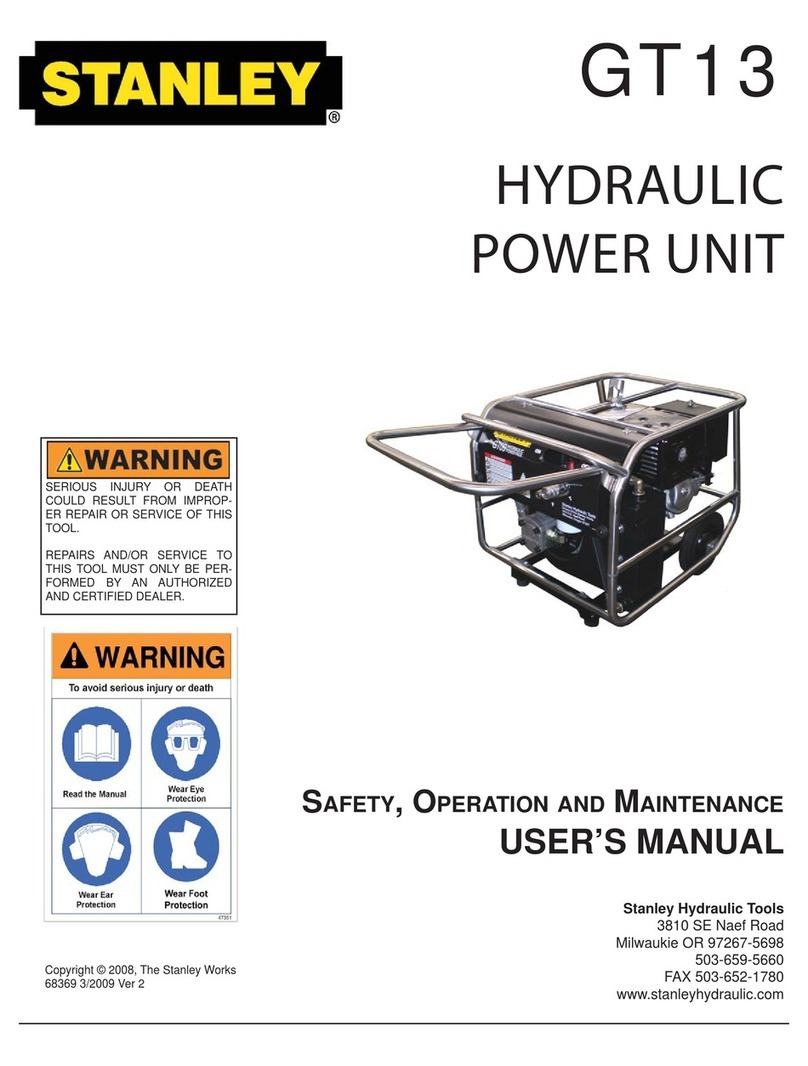
Stanley
Stanley GT13 Safety, operation and maintenance user's manual

Delta Electronics
Delta Electronics PMC-24V150W2AA instruction manual
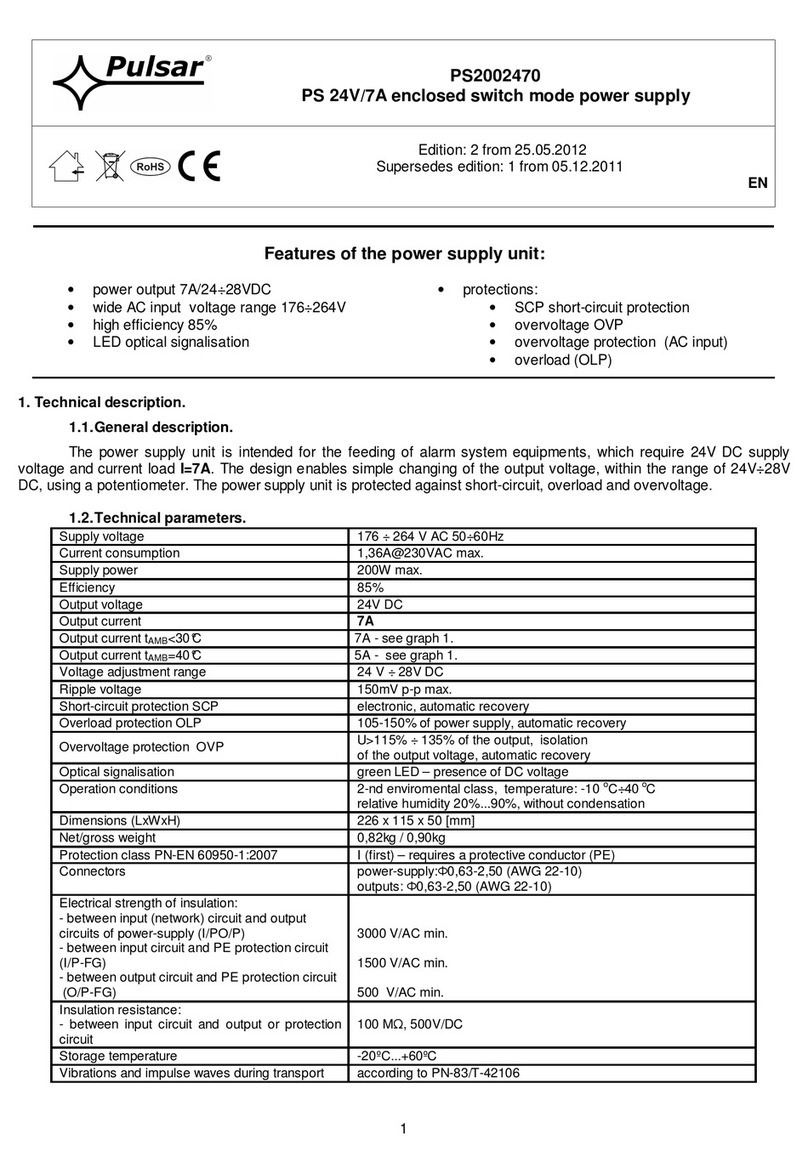
Pulsar
Pulsar PS2002470 manual
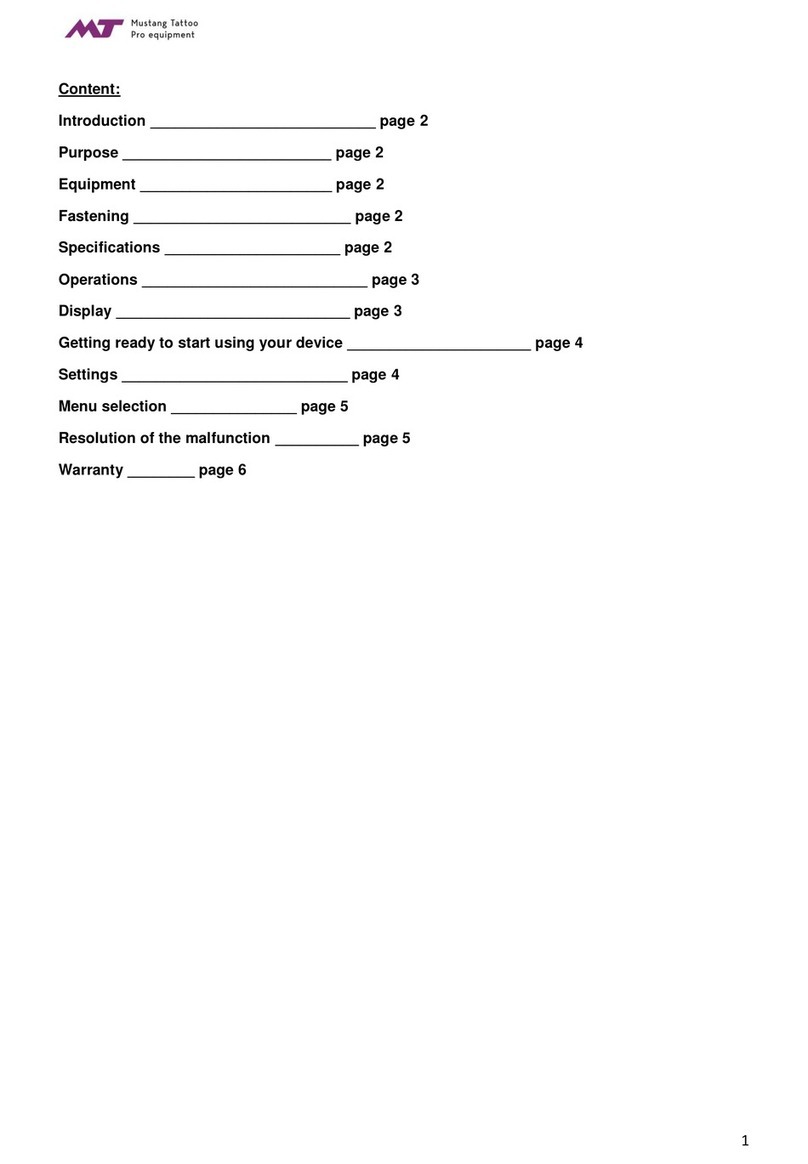
MT Mustang Tattoo
MT Mustang Tattoo POWER EXPERT quick start guide

EMS
EMS FC-60-1000 Technical bulletin

Stanley
Stanley FATMAX PP1DCS instruction manual
